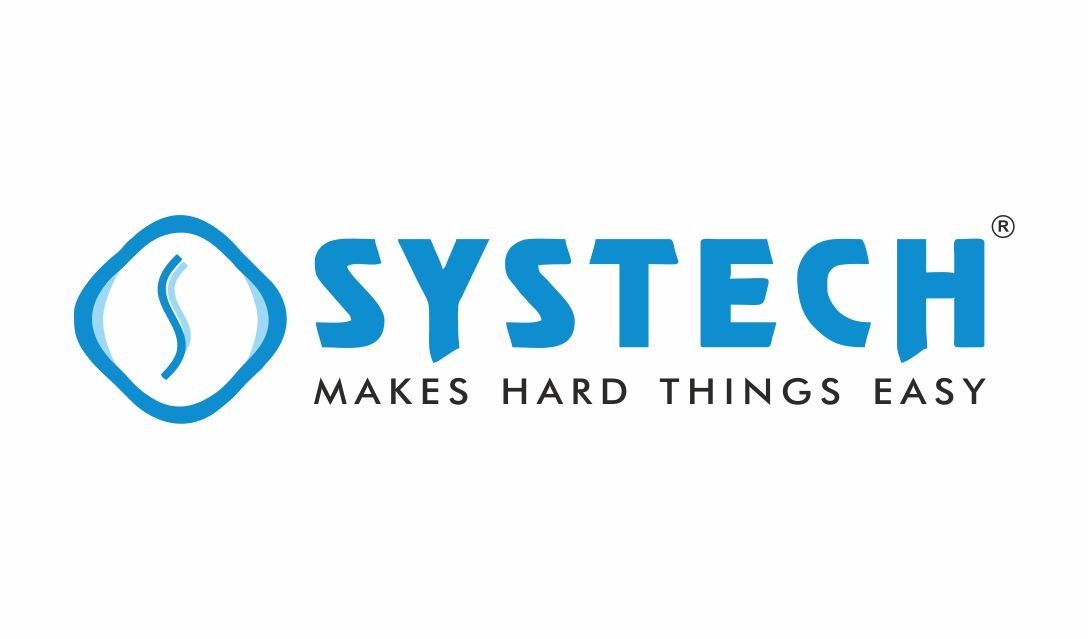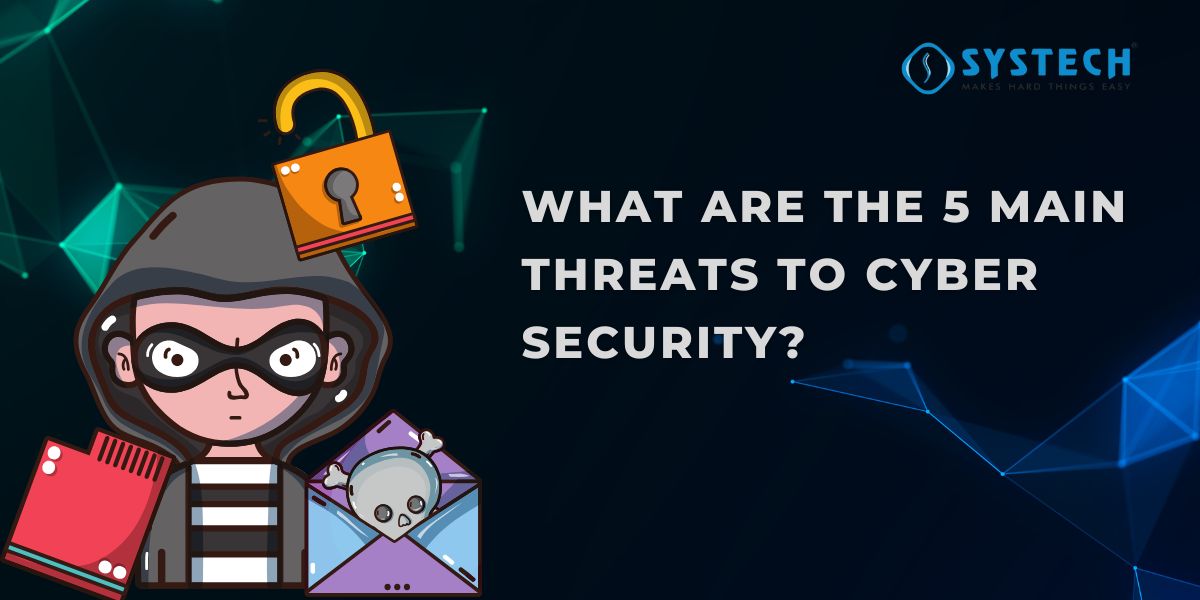Table of Contents
Introduction to Cyber Security Threats
As businesses and individuals embrace digital transformation, cyber security has become a major concern. The risks associated with cyber threats can be extremely costly, both in terms of financial losses and damage to a company’s reputation. Cyber security and solutions are now integral parts of organizational strategy, aimed at reducing the vulnerability of systems and data.
From malware infections to sophisticated phishing schemes, cybercriminals are constantly evolving their tactics to gain access to critical information. Businesses need to be proactive and vigilant in their approach to cyber security to minimize the impact of these threats. Understanding the types of computer security threats and their potential consequences is the first step toward creating an effective defense.
Top 5 Main Threats to Cyber Security
Cyber threats come in various forms, each targeting different vulnerabilities. Below are the 5 main threats to cyber security that every organization should be aware of.
Malware
Malware, short for malicious software, is a blanket term that covers a wide range of harmful programs, including viruses, worms, spyware, and trojans. These programs are designed to infiltrate and damage computers, steal data, or gain unauthorized access to systems.
- How malware works: Malware typically spreads through infected email attachments, compromised websites, or infected software downloads. Once installed, malware can perform a variety of harmful actions such as corrupting files, stealing data, or creating backdoors that allow attackers to control the system remotely.
- Preventing malware attacks: One of the best defenses against malware is using up-to-date antivirus software that can detect and remove malicious files. Regular software updates are crucial as they patch vulnerabilities that malware often exploits. Moreover, educating employees about the dangers of downloading attachments or clicking on suspicious links can further reduce the risk of infection.
Phishing Attacks
Phishing is a social engineering tactic in which attackers impersonate legitimate businesses, services, or individuals to trick victims into providing sensitive information such as usernames, passwords, or credit card numbers. Phishing attacks typically come in the form of deceptive emails or fake websites that appear authentic.
- How phishing works: Attackers often send emails that look like they are from trusted sources, such as banks, government agencies, or well-known companies. The emails prompt recipients to click on a link that leads to a fake login page where their login credentials are harvested.
- Preventing phishing attacks: To protect against phishing, it’s essential to educate employees and users on how to recognize suspicious emails and fake websites. Always verify the sender’s email address before clicking on links or downloading attachments. Using multi-factor authentication (MFA) is also highly recommended to reduce the risk of unauthorized access if login credentials are compromised.
Ransomware
Ransomware is a form of malicious software that encrypts files or locks down a system, rendering it inaccessible to the owner. The attacker then demands a ransom (usually in cryptocurrency) in exchange for the decryption key or to regain access to the system.
- How ransomware works: Ransomware is often spread through phishing emails, malicious ads, or exploit kits. Once the ransomware is activated, it encrypts files on the victim’s system and displays a ransom note demanding payment for decryption. In many cases, the ransom is never paid, and victims may lose their data permanently.
- Preventing ransomware attacks: Regular backups are critical in defending against ransomware. By backing up important data to an external drive or cloud service, businesses can recover their files without having to pay the ransom. Additionally, regularly updating software and using strong network security tools can help prevent ransomware from gaining access to systems in the first place.
Insider Threats
An insider threat refers to security risks posed by individuals within an organization who have access to sensitive data or systems. These threats can be intentional, such as employees stealing company secrets, or unintentional, such as employees accidentally disclosing sensitive information.
- How insider threats work: Insiders often have legitimate access to company data and systems, making them harder to detect than external attackers. They may misuse their privileges for financial gain or revenge, or they may unknowingly contribute to security breaches by mishandling sensitive information.
- Preventing insider threats: To mitigate insider threats, businesses should implement strong access control policies that limit access to sensitive data based on roles and responsibilities. Regularly monitoring and auditing access logs can help detect unusual activity. Employee training on security best practices and handling sensitive information is also essential.
Denial Of Service (DoS) Attacks
A Denial of Service (DoS) attack aims to disrupt the normal functioning of a network or website by overwhelming it with an excessive amount of traffic. A Distributed Denial of Service (DDoS) attack takes this a step further by using multiple systems to launch the attack, making it even harder to stop.
- How DoS attacks work: In a DoS attack, the attacker floods a network or website with traffic, often through a botnet (a network of compromised devices). This flood of traffic can cause the target website or server to crash or become slow and unresponsive.
- Preventing DoS attacks: Mitigating DoS attacks involves implementing rate-limiting mechanisms, load balancing, and firewalls that can filter out malicious traffic. Many organizations also work with content delivery networks (CDNs) or DDoS protection services that can absorb large volumes of traffic and ensure the continuity of services.
Cyber Security and Solutions
Addressing the cyber security threats outlined above requires a combination of preventative measures, tools, and strategies. Implementing cyber security solutions is essential for protecting sensitive data, maintaining network security, and ensuring business continuity. Solutions can range from firewalls, intrusion detection systems (IDS), and encryption to employee training programs and secure access protocols.
- Network security solutions: Deploy firewalls, IDS/IPS systems, and encryption to secure network communications and prevent unauthorized access to your system.
- Endpoint protection: Use security software on all devices connected to your network, including computers, mobile phones, and servers, to prevent malware infections and unauthorized access.
- Employee training: Cybersecurity is not just about technology—it’s also about people. Ensure that employees are trained on the dangers of phishing, password security, and best practices for handling sensitive information.
What Are The Threats To Network Security
Network security involves protecting the integrity and confidentiality of data as it is transmitted across or accessed from a computer network. Some of the biggest threats to network security include unauthorized access, malicious attacks, and data interception. These threats can cause significant damage to both individual users and entire organizations.
- How to protect network security: Use encryption to protect data in transit, implement access controls to restrict unauthorized access, and deploy firewalls and IDS/IPS systems to detect and prevent intrusions.
Cyber Security Threats in Computer Networks
Threats to computer networks come in many forms, including malware, DDoS attacks, and unauthorized access. These threats are particularly damaging because they can compromise entire systems, making data retrieval or system recovery difficult.
- How to protect against computer network threats: Regularly update all network hardware and software, segment networks to limit the impact of breaches, and monitor traffic patterns for signs of malicious activity.
How to Protect Against Information Security Threats
Information security threats can affect any aspect of your business’s data, including customer information, intellectual property, and proprietary systems. To safeguard your business, it’s crucial to take steps to protect this valuable asset.
- Protecting information: Use encryption to secure sensitive data, enforce strong password policies, and implement access control measures to ensure only authorized users can access critical data.
Conclusion
Cyber security is a constant battle, but by understanding the 5 main threats to cyber security, businesses can take proactive measures to protect their systems, networks, and sensitive data. From malware to insider threats, every attack can cause significant damage if not addressed appropriately. Adopting comprehensive cyber security solutions, monitoring networks, and educating employees about security best practices are all essential steps to minimizing risk and maintaining a secure environment.
Related Courses
FAQs
What is the most common cyber security threat?
Malware and phishing attacks are among the most common and widespread cyber security threats.
How can businesses protect themselves from cyber threats?
By using network security solutions, training employees, updating systems regularly, and implementing encryption protocols.
What are the threats to network security?
Unauthorized access, data interception, and DDoS attacks are common network security threats.
How do DoS attacks affect businesses?
DoS attacks can disrupt operations by overwhelming a business’s network, causing downtime and loss of revenue.
What is an insider threat?
Insider threats come from employees, contractors, or partners who may intentionally or unintentionally compromise security.
What are some ways to secure computer networks?
Use firewalls, implement encryption, regularly update software, and conduct network audits to identify vulnerabilities.
How do ransomware attacks work?
Ransomware locks down your system or files and demands payment for their release.
Why is data encryption important?
Encryption ensures that sensitive information is unreadable to unauthorized users, protecting it from theft or interception.
What is multi-factor authentication?
Multi-factor authentication is an additional layer of security that requires more than one form of verification to access systems.
How can phishing attacks be prevented?
Avoid clicking on links in unsolicited emails, use spam filters, and verify the legitimacy of requests before sharing sensitive information.
What should businesses do if they experience a cyber attack?
Businesses should immediately isolate affected systems, notify authorities, and begin an incident response protocol to assess the damage.
How often should security software be updated?
Security software should be updated regularly, with patches applied as soon as they are released to address vulnerabilities.

